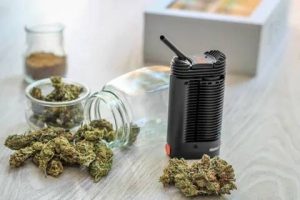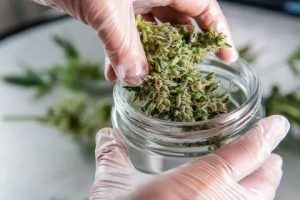
The best delivery method for weed ultimately depends on personal preference and the desired effects you are seeking. Here are some common methods of consuming weed:
Smoking:
Smoking is one of the most common and traditional methods of consuming weed. Here are some popular smoking methods:
- Joint: A joint is a hand-rolled cigarette using rolling papers. Ground cannabis flower is typically mixed with tobacco or smoked on its own. It is a straightforward and portable method.
- Pipe: Pipes are small handheld devices made of glass, metal, wood, or other materials. They have a bowl to hold the cannabis flower and a mouthpiece to inhale the smoke. Pipes are easy to use and convenient for on-the-go consumption.
- Bong: Also known as a water pipe, a bong filters smoke through water, providing a smoother and cooler hit. It typically consists of a bowl, a water chamber, and a mouthpiece. Bongs come in various sizes and designs.
- Blunt: Similar to joints, blunts are hand-rolled cannabis cigarettes. However, instead of rolling papers, blunts are made using tobacco leaf wraps or hollowed-out cigars. They tend to burn slower and can contain more cannabis than a joint.
- Hookah: While traditionally used for smoking flavored tobacco, hookahs can also be used for cannabis. A hookah consists of a water-filled base, a bowl, a hose, and a mouthpiece. Cannabis is placed in the bowl, heated with charcoal, and the smoke is drawn through the water before inhalation.
It’s worth noting that smoking any substance, including weed, can have potential health risks associated with inhaling combustion byproducts. If you prefer a potentially healthier alternative, vaporizing or consuming edibles might be options to consider.
Vaporizing:
Vaporizing is a popular method for consuming weed that involves heating cannabis to a temperature that releases cannabinoids and terpenes without combustion. This produces a vapor that can be inhaled. Here’s more information on vaporizing as a weed delivery method:
- Dry Herb Vaporizers: Dry herb vaporizers are designed to heat dried cannabis flower to a specific temperature range that vaporizes the cannabinoids and terpenes without burning the plant material. These vaporizers typically have a chamber where you place the ground cannabis flower. They come in various sizes, from portable handheld devices to larger tabletop models.
- Vaporizer Pens: Vaporizer pens, also known as vape pens, are compact and portable devices that vaporize cannabis oil or concentrates. They consist of a battery, a heating element, and a cartridge or chamber that contains the cannabis oil or concentrate. Vape pens are convenient and discreet, making them a popular choice for on-the-go use.
- Tabletop Vaporizers: Tabletop vaporizers are larger devices that require a power source and are typically used at home. These vaporizers often have more precise temperature controls and can accommodate larger amounts of cannabis flower or concentrates. They are known for delivering high-quality vapor and are popular among cannabis enthusiasts.
Vaporizing is considered by many to be a healthier alternative to smoking because it eliminates the combustion process, which can produce harmful byproducts. Vaporizers heat the cannabis material to a temperature that releases the desired compounds while reducing the inhalation of potentially harmful substances.

Edibles:
Edibles are a popular method of consuming weed, and they refer to cannabis-infused food and beverages. Here’s more information about edibles as a weed delivery method:
- Baked Goods: This category includes cookies, brownies, cakes, and other baked goods infused with cannabis. The cannabis is typically added to the recipe by using cannabis-infused butter (cannabutter) or cannabis-infused cooking oil. Baked goods are known for their delicious taste and ease of consumption.
- Chocolates and Candies: Cannabis-infused chocolates and candies come in various forms, such as bars, truffles, gummies, hard candies, and more. They are often infused with cannabis extracts or distillates and provide a discreet York weed delivery and convenient way to consume cannabis.
- Beverages: Cannabis-infused beverages include a range of options like teas, coffees, sodas, juices, and even infused alcoholic drinks. These beverages are typically infused with cannabis extracts or cannabinoids, and they offer an alternative to traditional methods of consumption.
- Tinctures and Sublinguals: Tinctures are liquid extracts made by soaking cannabis flower in alcohol or oil. They are usually administered by placing drops under the tongue (sublingually) for fast absorption into the bloodstream. Tinctures provide a precise and discreet way to consume cannabis and allow for easy dose control.
- Capsules and Pills: Cannabis capsules and pills are pre-measured doses of cannabis oil or extract contained within gelatin or vegetarian capsules. They provide a convenient and familiar method of consumption, similar to taking other oral medications or supplements.
Edibles have some unique characteristics compared to other methods of consuming weed. When ingested, the cannabinoids are metabolized by the liver, resulting in a different onset and duration of effects compared to smoking or vaporizing. The effects of edibles can take longer to kick in, usually ranging from 30 minutes to two hours, but they can also last longer, often for several hours.
Tinctures:
Tinctures are liquid extracts made by soaking cannabis flowers or concentrates in alcohol or oil. They are a versatile and discreet method of consuming weed. Here’s more information about tinctures as a weed delivery method:
- Administration: Tinctures are typically consumed sublingually, which means you place a few drops under your tongue and hold them there for a short period before swallowing. This allows for faster absorption of cannabinoids into the bloodstream through the mucous membranes under the tongue.
- Precise Dosing: Tinctures offer precise dosing control. They are usually sold with a dropper or measured dispenser, allowing you to easily adjust your dosage based on your tolerance, desired effects, and experience level. It’s recommended to start with a low dose and gradually increase if needed.
- Quick Onset: Compared to edibles, tinctures have a relatively fast onset of effects. You can typically expect to feel the effects within 15-30 minutes after administration, although this can vary depending on the individual and the specific tincture formulation.
- Discreet and Odorless: Tinctures are discreet and do not have the strong smell often associated with smoking or vaporizing cannabis. They are convenient for those who prefer a more inconspicuous method of consumption, especially in situations where the smell or act of smoking is not desirable.
- Versatility: Tinctures can be made with different strains of cannabis, allowing for a wide range of cannabinoid profiles and effects. They can also be formulated with specific ratios of THC (tetrahydrocannabinol) and CBD (cannabidiol) or other cannabinoids, catering to various preferences and medicinal needs.
- Potential Applications: Tinctures are used for various purposes, including pain relief, anxiety management, relaxation, sleep support, and more. Some tinctures are specifically formulated for specific effects, such as energizing or calming properties.
When using tinctures, it’s essential to follow the instructions provided by the manufacturer. Shake the bottle well before each use to ensure proper distribution of the cannabis extract. Start with a low dose and give yourself enough time to gauge the effects before considering taking more. It’s important to be aware of the potency and concentration of the tincture you are using.
Transdermal patches:
Transdermal patches are a unique and increasingly popular method of delivering cannabinoids, including those found in cannabis, into the body. Here’s more information about transdermal patches as a weed delivery method:
- Application: Transdermal patches are applied directly to the skin, where they release cannabinoids gradually over an extended period. The patches are typically infused with cannabis extracts or isolated cannabinoids, such as THC or CBD. They are designed to penetrate the skin and deliver the cannabinoids into the bloodstream.
- Controlled Release: Transdermal patches provide a controlled and consistent release of cannabinoids. They are designed to deliver a specific dosage over a set period, typically ranging from several hours to a full day. This controlled release allows for a more predictable and steady experience compared to other methods of consumption.
- Long-Lasting Effects: Due to the sustained release of cannabinoids, transdermal patches provide long-lasting effects. The duration can vary depending on the patch’s formulation and dosage, but it is generally longer than other methods like smoking or vaping.
- Discreet and Odorless: Transdermal patches are discreet and odorless, making them an ideal choice for individuals who prefer a more inconspicuous way of consuming cannabis. The patches can be applied discreetly under clothing and do not produce the characteristic smell associated with smoking or vaping.
- Targeted Relief: Transdermal patches can be designed to provide localized or systemic effects. For example, patches infused with cannabinoids like CBD or THC can be placed directly over an area experiencing pain or inflammation to provide targeted relief. This localized application allows for more precise and focused relief compared to other consumption methods.
- Minimal Psychoactive Effects: Transdermal patches are often formulated to provide therapeutic benefits without significant psychoactive effects. For individuals seeking the potential medicinal benefits of cannabinoids without the intense high, transdermal patches can offer a suitable option.
It’s important to note that the effectiveness of transdermal patches can vary among individuals. Factors such as skin type, patch placement, and individual metabolism can influence the patch’s absorption and resulting effects. It’s advisable to start with a low-dose patch and monitor your response before adjusting the dosage.